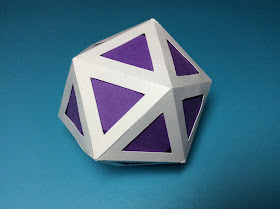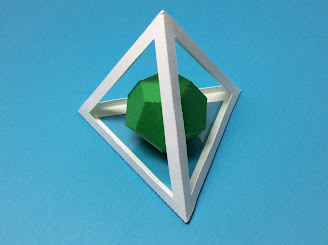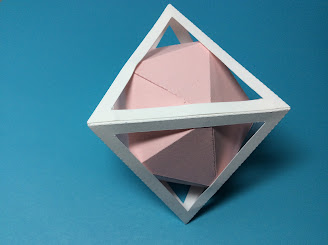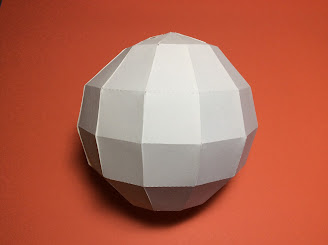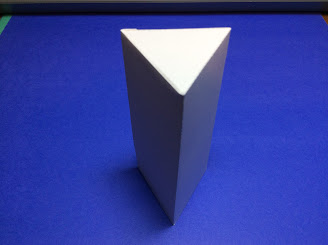In the style of Da Vinci's polyhedra model drawings from Pacioli's Divine Proportion book, I inscribed more polyhedra in this blog posting. I think these are excellent models for students to explore the concept of stellating and truncating Platonic solids.
Monday, August 31, 2020
A STEM Project: More Inscribed Polyhedra Based on Pacioli's Divine Proportion Book
A STEM Project: Inscribing Da Vinci's Divine Proportion Polyhedra Models
After making Da Vinci's divine proportion polyhedra models, see blog posts https://papercraftetc.blogspot.com/2020/08/a-stem-project-constructing-da-vincis.html and https://papercraftetc.blogspot.com/2020/08/a-stem-project-constructing-da-vincis_21.html, I decided to inscribe the polyhedra models into one another. Pacioli wrote in his Divine Proportion book about these inscriptions.
The five Platonic solids, the tetrahedron, cube, octahedron, icosahedron and dodecahedron, can be derived from a single one, the dodecahedron, which, according to Pacioli, "sustains the existence of all the others and governs the manifold harmonies and interrelations among all five". Since the dodecahedron is the basis for all others, Pacioli claimed that it would be only mathematically possible with a specific proportion which he named the "Divine Proportion".
Pacioli wrote about inscriptions of the five Platonic solids solids using the sphere method of calculating the side lengths of the interior polyhedron. I inscribed the Platonic solids as I thought Da Vinci would have done if he had the Silhouette software and cutting technology.
"Computing maximal copies of polytopes contained in a polytope", by Moritz Firsching, Institut fu ̈r Mathematik FU Berlin Arnimallee 2 14195 Berlin Germany, July 16, 2018 https://arxiv.org/pdf/1407.0683.pdf *
The following calculations were cited in this paper:
1). Cube in a Tetrahedron. The side length of the cube was calculated as 0.296 x 3 = 0.888 inches.
2). Octahedron in a Tetrahedron. The side length of the octahedron was calculated as 0.500 x 3 = 1.5 inches.
6). Octahedron in a Cube. The side length of the octahedron is calculated as 1.06 x 2 = 2.12 inches.
7). Dodecahedron in a Cube. The side length of the dodecahedron is calculated as 0.394 x 2 = 0.788 inches.
8). Icosahedron in a Cube. The side length of the icosahedron is calculated as 0.618 x 2 = 1.236 inches.
10). Cube in an Octahedron. The side length of the cube is calculated as 0.586 x 3 = 1.758 inches.
11). Dodecahedron in an Octahedron. The side length of the dodecahedron is calculated as 0.313 x 3 = 0.939 inches.
12). Icosahedron in an Octahedron. The side length of the icosahedron is calculated as 0.54 x 3 = 1.62 inches.
14). Cube in a Dodecahedron.
15). Octahedron in a Dodecahedron.
16). Icosahedron in a Dodecahedron.
18). Cube in an Icosahedron. The side length of the cube is calculated as 0.939 x 2 = 1.878 inches.
19). Octahedron in an Icosahedron. The side length of the octahedron is calculated as 1.181 x 2 = 2.362 inches.
20). Dodecahedron in an Icosahedron. The side length of the dodecahedron is calculated as 0.58 x 2 = 1.16 inches.
Friday, August 21, 2020
A STEM Project: Constructing Da Vinci's Divine Proportion Polyhedra Models - Part 2 of 2
I duplicated Da Vinci's drawings by constructing three-dimensional paper models. In my description, I will give the side length measure and describe each model based on the number of faces, edges and vertices using Euler's formula. For any convex polyhedron, the number of vertices and faces together is exactly two more than the number of edges. Vertices + Faces - Edges = 2
A face is a flat, two-dimensional surface that serves as one side of a polyhedron.
An edge is a line segment where two faces meet.
Vertices is the plural of vertex. Vertices are corner points which are formed by the intersection of faces.
Plate XXXI, XXXII - Solid & Hollow Elevated Dodecahedron aka Small Stellated Dodecahedron | Side Length of 1.618 inches |
Faces | 60 equilateral triangles |
Edges | 90 |
Vertices | 32 |
Plate XXXIII, XXXIV - Solid & Hollow Elevated Truncated Dodecahedron | Side Length of 1.618 inches |
Faces | 120 equilateral triangles |
Edges | 180 |
Vertices | 62 |
Plate XXXV, XXXVI - Solid & Hollow Icosahexahedron aka Rhombicuboctahedron or Small Rhombic Cuboctahedron | Side Length of 1.618 inches |
Faces | 18 squares, 8 equilateral triangles |
Edges | 48 |
Vertices | 24 |
Plate XXXVII, XXXVIII - Solid & Hollow Elevated Icosahexahedron aka Augmented Rhombicuboctahedron or Moravian Star | Side Length of 1.618 inches |
Faces | 96 equilateral triangles |
Edges | 144 |
Vertices | 50 |
Plate XXXIX, XL - Solid & Hollow Septuagintaduarium Basium | Varying side lengths |
Faces | 24 isosceles triangles, 48 trapezoids |
Edges | 132 |
Vertices | 62 |
Plate XLI, XLII - Solid & Hollow Triangular Lateral Column | 3.725 in. x 1.618 in. |
Faces | 2 equilateral triangles, 3 rectangles |
Edges | 9 |
Vertices | 6 |
Plate XLIII, XLIV - Solid & Hollow Triangular Lateral Pyramid | 3.725 in.height x 1.618 in.base |
Faces | 1 equilateral triangle, 3 isosceles triangles |
Edges | 6 |
Vertices | 4 |
Plate XLV, XLVI - Solid & Hollow Quadrangular Lateral Column | 3 in. x 1.618 in. |
Faces | 2 squares, 4 rectangles |
Edges | 12 |
Vertices | 8 |
Plate XLVII, XLVIII - Solid & Hollow Quadrangular Lateral Pyramid | 3 in. X 1.618 in. |
Faces | 1 square, 4 isosceles triangles |
Edges | 8 |
Vertices | 5 |
Plate XLIX, L - Solid & Hollow Pentagonal Lateral Column | 4.3 in. x 1.618 in. |
Faces | 2 pentagons, 5 rectangles |
Edges | 15 |
Vertices | 10 |
Plate LI, LIII- Solid & Hollow Pentagonal Lateral Pyramid | 4.3 in. x 1.618 in. |
Faces | 1 pentagon, 5 isosceles triangles |
Edges | 10 |
Vertices | 6 |


Plate LIII, LIV - Solid & Hollow Hexagonal Lateral Column | 5.2 in. x 1.618 in. |
Faces | 2 hexagons, 6 rectangles |
Edges | 18 |
Vertices | 12 |


Plate LIV, LV - Solid & Hollow Inequilateral Triangular Lateral Pyramid | Varying sizes |
Faces | 4 triangles |
Edges | 6 |
Vertices | 4 |
Plate LVII - Solid Round Column | 4.5 in. x 1.618 in. |
Faces | 2 circles |
Edges | 0 |
Vertices | 0 |
Plate LVIII - Solid Cone | 4.5 in. x 1.618 in. |
Faces | 1 circle |
Edges | 0 |
Vertices | 1 |









